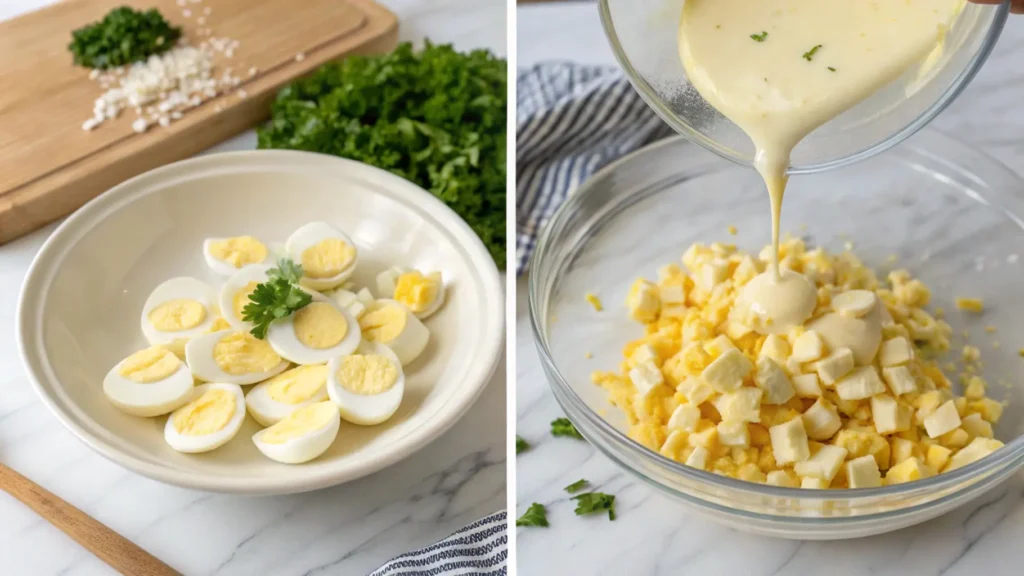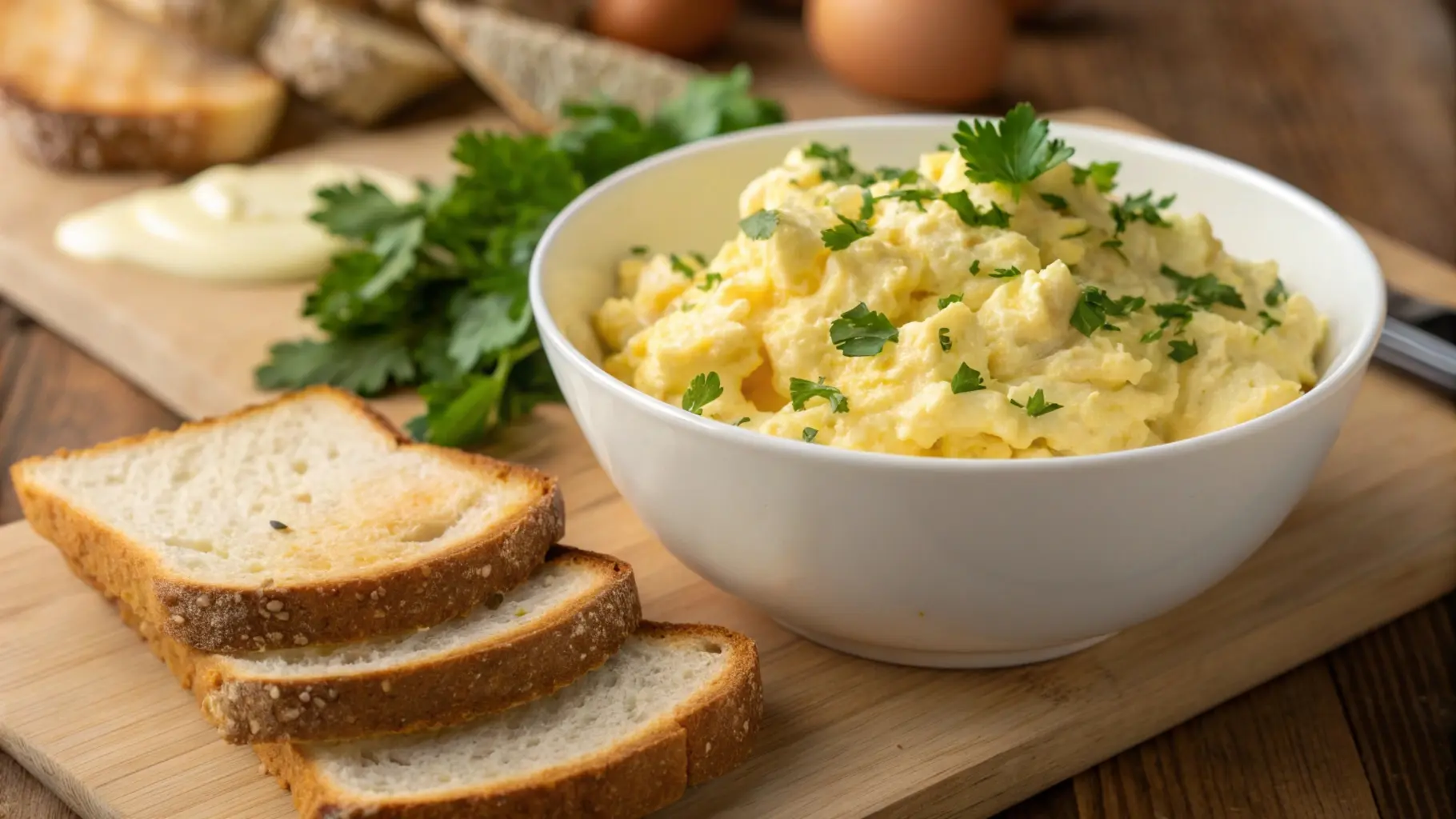Egg salad is a beloved classic, perfect for sandwiches, wraps, or as a side dish. But many wonder how to stop egg salad from getting watery, as its creamy texture can quickly turn into a soggy mess. In this article, we’ll share practical tips for selecting the right ingredients, using proper preparation methods, and storing your salad to maintain its consistency and flavor
Understanding the Problem
Why Does Egg Salad Become Watery?
Egg salad often becomes watery due to excess liquid in the ingredients or improper preparation techniques. For instance, low-fat mayonnaise, which contains more water than full-fat varieties, can introduce unwanted moisture. Similarly, overcooked eggs release water as their proteins break down, contributing to a runny texture.
Another culprit? Watery add-ins like celery or cucumbers, which release moisture over time. As the salad sits, this water seeps out, creating that unappealing pool at the bottom of the bowl.
Common Ingredients That Cause Wateriness
While mayonnaise is a well-known contributor, other ingredients can exacerbate the issue. Vegetables with high water content, such as onions or bell peppers, may sound like good additions but often lead to soggy results. Even mustard, if used excessively, can throw off the balance.
In addition, improperly drained boiled eggs can hold onto residual moisture, adding to the problem. Each ingredient plays a role in the final consistency, so choosing wisely is key.
Impact of Storage on Egg Salad Consistency
Egg salad is notorious for getting watery during storage. Why? The process of osmosis causes water to migrate from the ingredients into the dressing. Refrigeration can further accelerate this, especially if the salad isn’t stored in an airtight container. Over time, the mixture separates, leaving you with a watery mess.
But don’t worry! Later in this article, we’ll cover simple storage hacks to keep your egg salad fresh and firm. For now, understanding the problem is the first step to crafting the perfect egg salad.
Choosing the Right Ingredients
Selecting the Best Eggs
The foundation of any great egg salad lies in the eggs themselves. Using fresh, high-quality eggs can make a noticeable difference. Stale eggs tend to have a looser texture after boiling, which can contribute to a watery salad. To pick the freshest eggs, check the expiration date on the carton and perform a simple water test: fresh eggs sink while older ones float.
Once boiled, make sure the eggs are cooled and peeled properly to avoid cracking, which might allow water to seep into the whites. By starting with firm, evenly boiled eggs, you’re already on your way to tackling the question of how to stop egg salad from getting watery.
The Role of Mayonnaise and Alternatives

Mayonnaise is a staple in most egg salad recipes, but not all types are created equal. Low-fat or fat-free varieties often contain added water, which can increase the likelihood of separation. For a firmer consistency, stick with full-fat mayonnaise or try a mix of mayo and plain Greek yogurt. The yogurt adds creaminess while introducing less water to the mix.
Another option is experimenting with alternatives like mashed avocado or hummus. These choices provide moisture and flavor without the risk of water pooling at the bottom of the dish.
Additional Ingredients That Help Maintain Texture
Not all ingredients play well with egg salad’s consistency. To maintain a thick, creamy texture, avoid adding high-water-content vegetables like cucumbers or tomatoes. Instead, consider ingredients that absorb moisture, such as finely diced celery, shredded carrots, or even a touch of grated cheese. These add-ons bring crunch and flavor while keeping the salad from turning into a watery mess.
Perfecting the Preparation Method
Boiling Eggs the Right Way
Believe it or not, how you boil your eggs can directly impact the consistency of your egg salad. Overcooking eggs causes them to release sulfur and extra moisture, which can affect the texture. To get it right, place your eggs in a pot of cold water, bring it to a gentle boil, and then let them simmer for about 9-12 minutes.
Once boiled, transfer the eggs to an ice bath immediately. This step halts the cooking process and prevents the eggs from retaining heat, which could cause sweating and water buildup. Proper boiling is one of the simplest answers to how to stop egg salad from getting watery.
Proper Chopping and Mixing Techniques

The way you prepare your ingredients also matters. When chopping boiled eggs, aim for uniform pieces. Uneven chunks can lead to a mixture where some parts retain more moisture than others. Use a gentle hand when mixing, ensuring the ingredients are just combined without mashing them too much.
Adding the mayonnaise gradually instead of all at once helps you control the consistency. Mix a little at a time until the desired creaminess is achieved. This careful approach minimizes the risk of over-saturating the salad.
Avoiding Excessive Liquids During Preparation
Egg salad recipes often include mustard, pickle juice, or other liquid seasonings for flavor. While tasty, these can quickly turn the salad watery if used in large amounts. A good rule of thumb is to add liquids sparingly, tasting as you go to strike the right balance.
If you’re adding pickles or relish, drain them well before mixing them into the salad. Even a small amount of excess liquid can alter the texture significantly. By controlling these elements, you’ll be well on your way to perfecting the preparation process—and solving the problem of how to stop egg salad from getting watery once and for all.
Storing Egg Salad Properly
Ideal Refrigeration Practices
Proper storage is key to preventing your egg salad from turning watery. Always store the salad in an airtight container to minimize air exposure, which can cause ingredients to break down and release moisture. For the best results, refrigerate your egg salad immediately after preparation. Keeping it cold slows down the separation process, helping maintain its creamy texture.
Avoid storing the salad in a container that’s too large for the amount of food. Extra space inside the container can lead to condensation, further contributing to a watery mixture. Small adjustments like these go a long way in solving how to stop egg salad from getting watery during storage.
How Long Can Egg Salad Be Stored?
Egg salad is best consumed fresh but can be stored in the refrigerator for up to three days. Beyond this period, the risk of spoilage increases, and the texture may deteriorate. If you notice any separation, gently stir the salad before serving to redistribute the moisture evenly.
It’s also wise to use the freshest ingredients when making egg salad, as this extends its shelf life and keeps it tasting its best. Remember, properly stored egg salad isn’t just about freshness—it’s about keeping that ideal creamy consistency, too.
Reusing Leftover Egg Salad Without Wateriness
If you find yourself with leftovers that are starting to get watery, don’t worry! Add a little extra chopped boiled egg or a dollop of mayonnaise to restore the thickness. Avoid adding water-heavy ingredients, as they’ll only make the problem worse.
For more great tips, check out our article on how to handle egg-based recipes effectively.
Creative Tweaks and Fixes
Adding Ingredients to Absorb Excess Liquid
A simple fix for watery egg salad is to introduce moisture-absorbing ingredients. A sprinkle of breadcrumbs or crushed crackers can work wonders, especially if the salad will be consumed immediately. These additions blend smoothly into the mixture, improving both texture and taste.
Another option is finely chopped vegetables like celery or carrots. These crunchy ingredients not only soak up excess liquid but also add a burst of flavor. Keeping your salad balanced with dry and moist elements is a surefire way to answer how to stop egg salad from getting watery.
Substituting Common Ingredients to Improve Texture
Consider swapping out problematic ingredients for less watery alternatives. For example, replace low-fat mayonnaise with a blend of full-fat mayonnaise and Greek yogurt. If you prefer a lighter option, mashed avocado or hummus can achieve similar creaminess without introducing extra water.
For flavor enthusiasts, adding spices like paprika or dill can improve the taste without affecting the consistency. Little tweaks like these keep your egg salad thick and flavorful.
Recipes With Adjusted Ingredients for Better Consistency
Why not try variations of egg salad that naturally avoid wateriness? A curried egg salad or a bacon and egg salad uses fewer liquid ingredients and maintains a firmer texture. Experimenting with new recipes not only keeps your meals exciting but also guarantees your salad remains the creamy delight it’s meant to be.
For more inspiration, check out our take on egg-white buns for creative meals.
FAQs
What Causes Egg Salad to Get Watery Overnight?
Egg salad can turn watery overnight due to the high water content in some ingredients, like vegetables or low-fat mayonnaise. When these ingredients sit together, they release moisture into the mixture through a process called osmosis. Refrigeration can also speed up this separation. To avoid this, make certain that all ingredients, especially vegetables, are well-drained before mixing, and use an airtight container to store the salad. This is a key tip for how to stop egg salad from getting watery.
How Can I Fix Watery Egg Salad After Preparation?
If your egg salad becomes watery, don’t panic! There are easy fixes. You can mix in additional chopped boiled eggs or add a spoonful of mayonnaise to restore the consistency. Another trick is to incorporate moisture-absorbing ingredients like breadcrumbs or crushed crackers. These adjustments help salvage the salad without compromising its flavor.
Can I Use Low-Fat Mayonnaise Without Making the Salad Watery?
Low-fat mayonnaise often contains more water, which increases the risk of a watery salad. However, you can balance this by using a combination of low-fat mayo and plain Greek yogurt. The yogurt adds thickness and reduces water content, keeping the texture creamy.
Is Greek Yogurt a Good Substitute for Mayonnaise in Egg Salad?
Yes, Greek yogurt works wonderfully as a substitute for mayonnaise. It provides a tangy flavor and creamy texture without the extra water content that can lead to a watery salad. This simple switch is another effective way to tackle how to stop egg salad from getting watery.
Conclusion
Egg salad is a simple and tasty dish, but it can quickly turn watery if not made or stored the right way. In this article, we’ve shared helpful tips to solve the problem of how to stop egg salad from getting watery. From choosing fresh ingredients to storing the salad properly, small changes can make a big difference.
The most important point is to know how each ingredient affects the texture. Whether it’s using thick mayonnaise, adding Greek yogurt, or mixing in dry ingredients like breadcrumbs, you can keep your salad creamy and delicious. And if it ever gets watery, don’t worry—there are easy fixes to save it.
Now it’s time to put these tips into practice and make the best egg salad yet!

